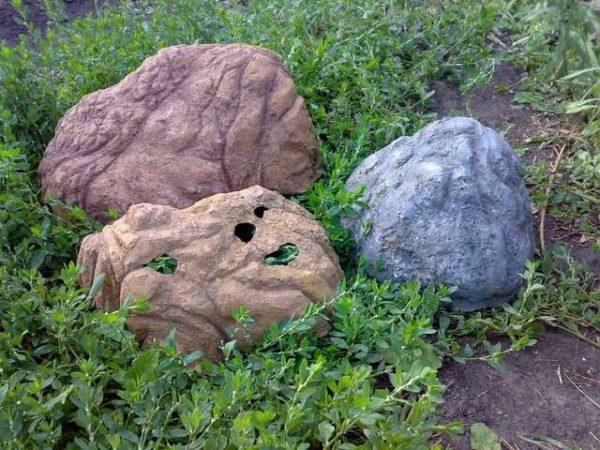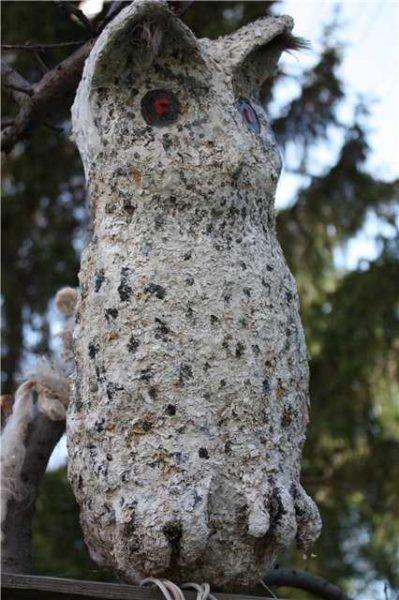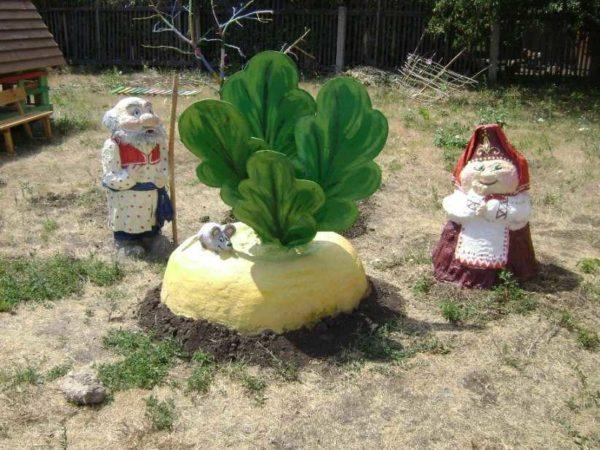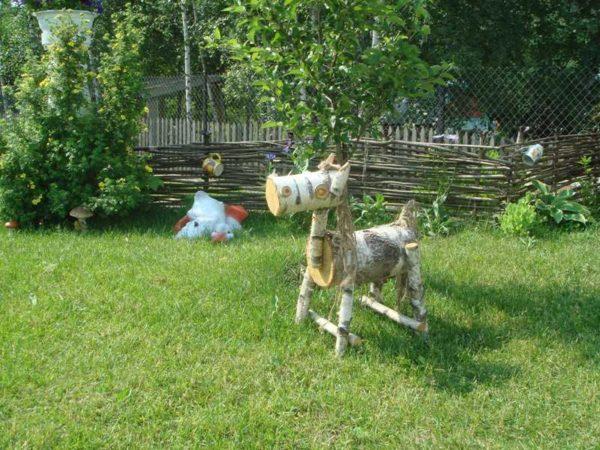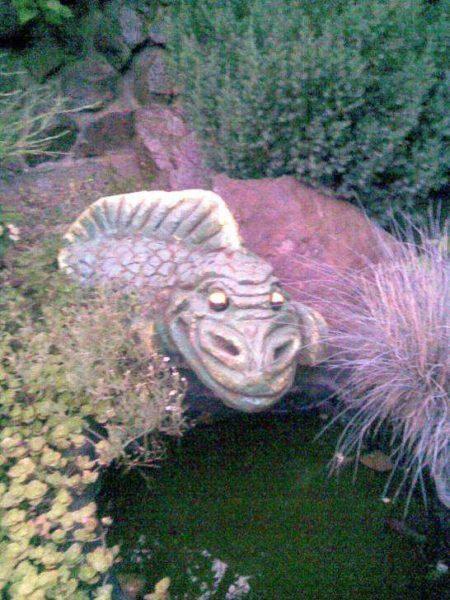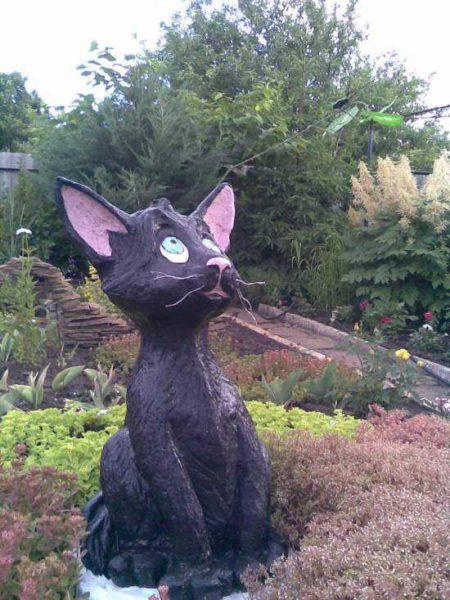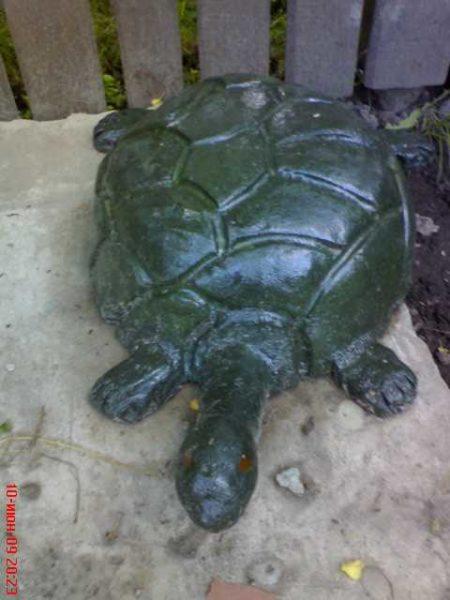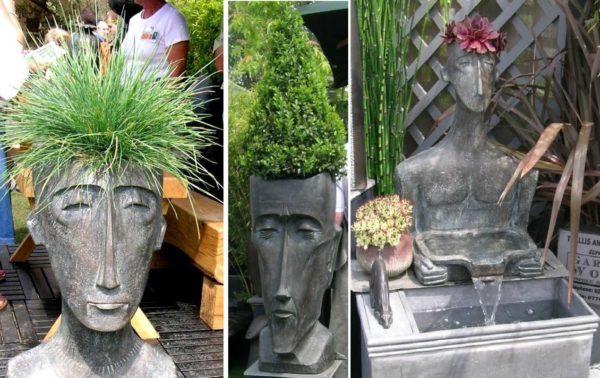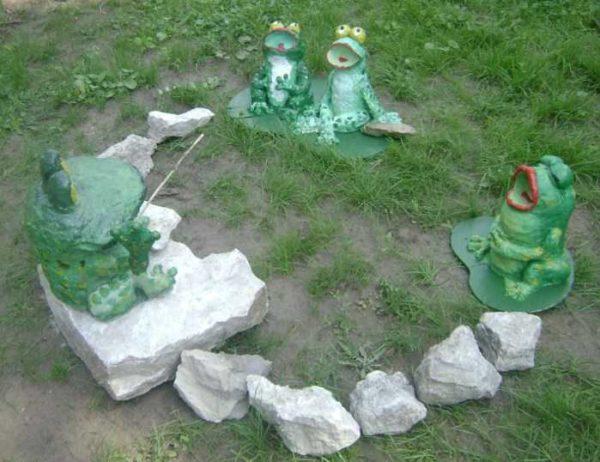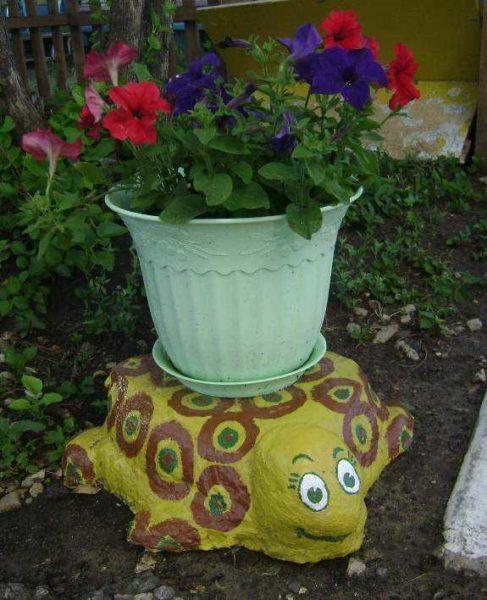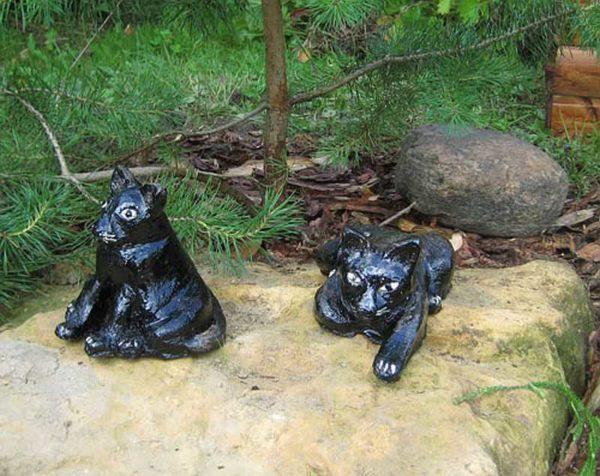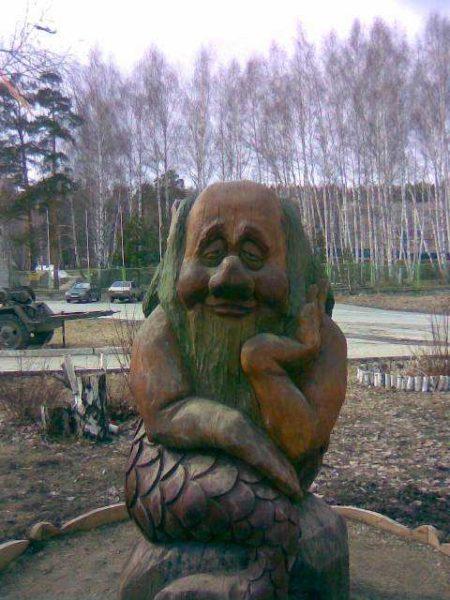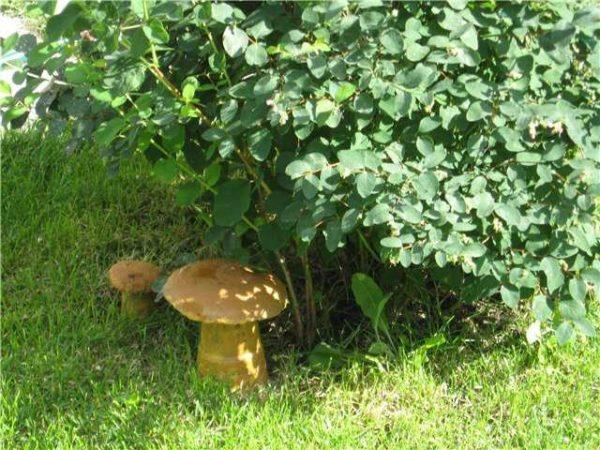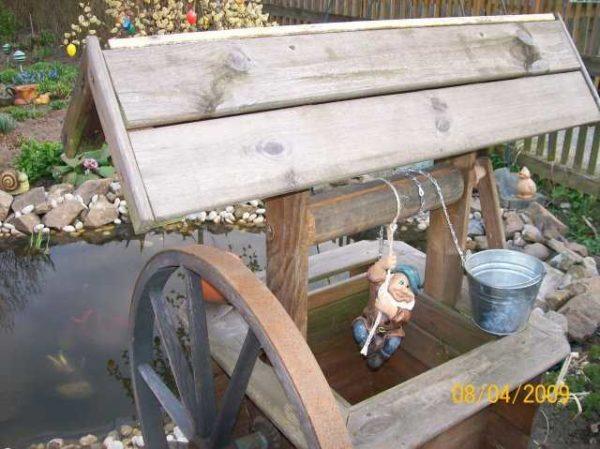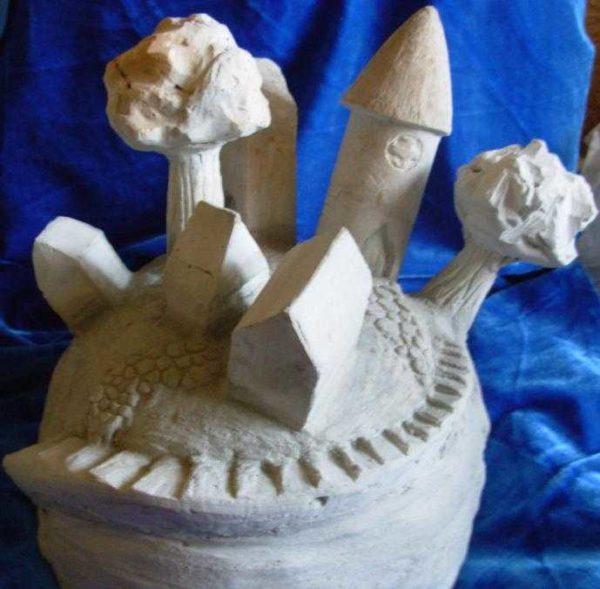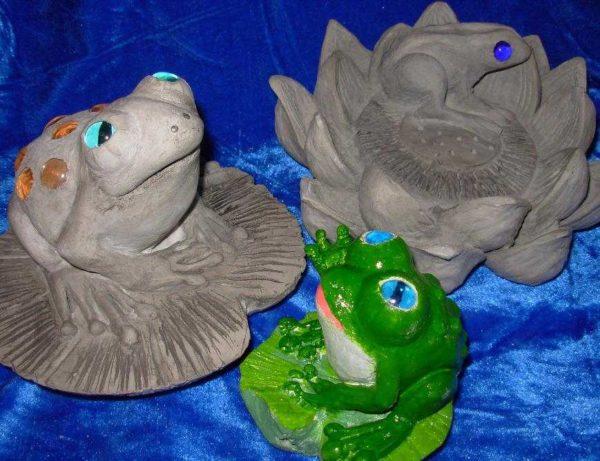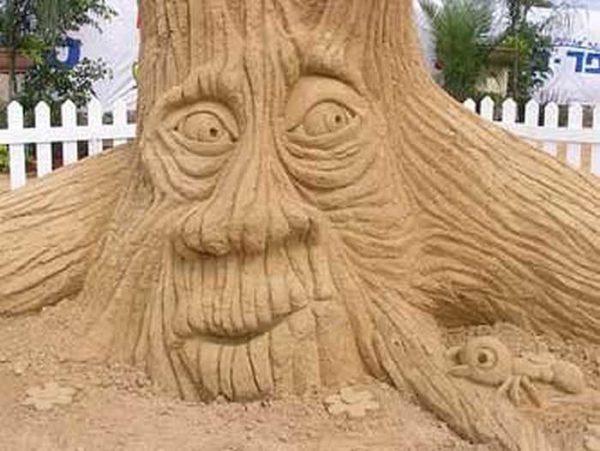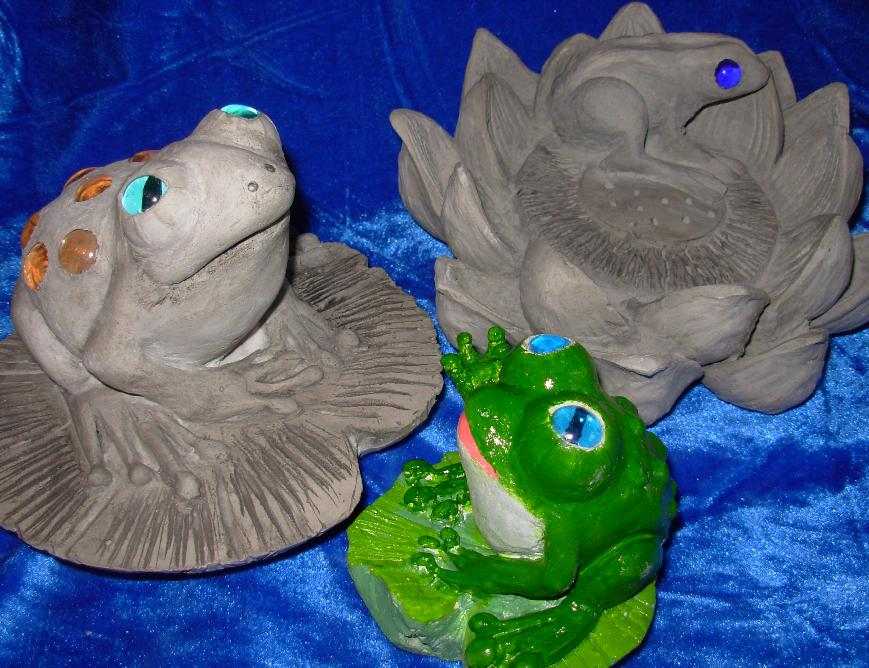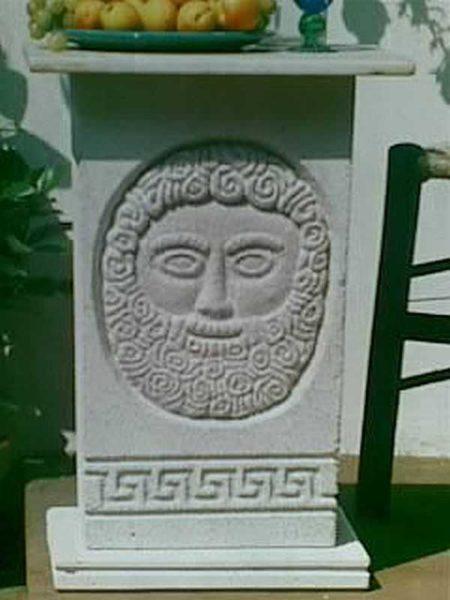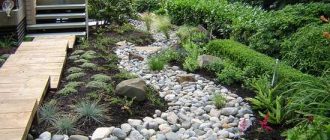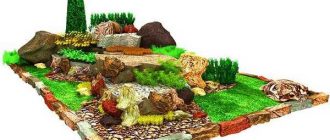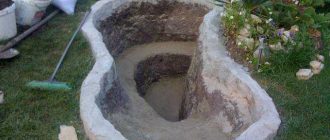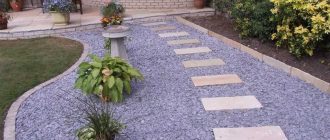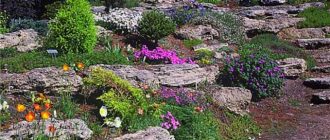Decorating a garden, homestead, dacha plot is an endless process. All the time something changes, is removed, added. One way to decorate is to make garden figures. If competently arrange them, they transform the appearance of the site.
Isi artikel
Figurines from cement: what are good and how to make them
Make garden figures can be made of cement – it is one of the most used and available materials. It is inexpensive, allows you to create a variety of figures – from simple and small, to full-length sculptures. There are several ways of how you can make garden figures from cement mortar: with a frame, without it, from semi-dry mortar. About all the details further on.
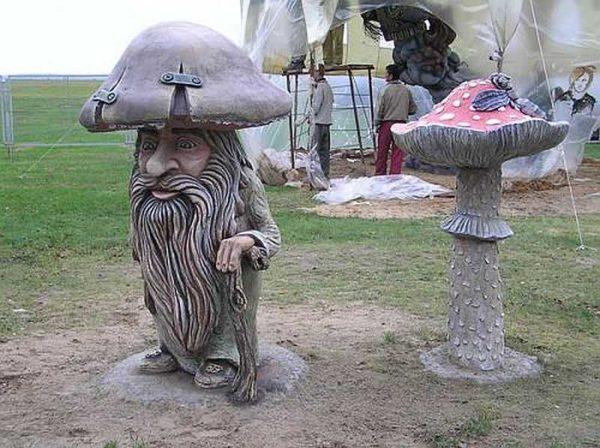
What to add to the mortar
There are many additives in cement that improve/change its properties. There are a lot of them, but they are sold in rather solid volumes, which may be necessary only for the manufacture of garden sculptures on an industrial scale. But there are common substances that also change the properties of concrete mortar.
- PVA glue – increases the frost resistance of the finished product and the plasticity of the liquid solution. It fills the mold better, but it “sets” faster. Dried cement with the addition of PVA can be processed many times worse than the usual. Therefore, do not miss the time until it can be molded.
- Liquid glass – reduce water permeability, the mortar sets faster. But it should be added no more than 1% of the total mass of the mortar.
- Plasticizer – an additive that increases the plasticity of semi-dry (with a small amount of water) concrete mortar. It is necessary to add quite a little, literally a teaspoon per bucket of mortar.
- To make the concrete lighter will help additive HYPERTUF.
- Washing powder or dishwashing liquid – works as a plasticizer and accelerates hardening. Add 0.5-1 teaspoon per bucket of mortar.
- To make the surface of the figure smoother, it can be covered with putty. But putty is needed not for walls, but for a wooden floor. It becomes very stiff after drying, but with concrete, it adheres firmly.
These are the main additives that are needed when making figures for the garden from concrete. It is easier to work with them. But do not add a lot. Maximum – one teaspoon per bucket, otherwise you will only make things worse.
What to paint and some technological nuances
After the concrete figure has dried, it should be sanded to smoothness, remove dust and you can paint. To make the paint lay down more evenly and less wasted, you must first cover the product with a layer of primer. The primer is selected depending on the type of paint. The painting process itself is no different – you usually need brushes of different sizes. But it is worth knowing some peculiarities.
There are still a lot of different technological nuances, but these are the main ones. The rest you will master or invent in the process of work.
How to make garden figures: cutting out of semi-dry mortar
Make garden figures from fresh cement-sand mortar will not work – it is too liquid. Even if you mix it with a minimum of water, you will not be able to make anything clear. But you can wait until the mortar becomes hardened, but still remains quite soft – it will crumble under pressure. In this state, you can use a metal object to make grooves in it, cut off the excess.
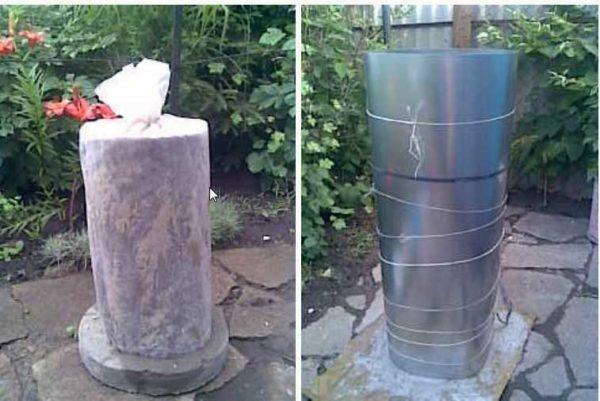
From the thick mixture, you can form the approximate shape of the intended character – lay it out in a piece of film, tie it, give the desired shape. If there is a liquid solution, find a more or less suitable container or use all the same film. The solution in the mold is left for 8-12 hours. The time depends on how liquid the cement was initially and the temperature at which you hold the product. The optimal temperature is about +20°C, at a lower temperature the time for hardening increases, and at a higher temperature, there is a possibility that the cement will dry out and not “grab”.
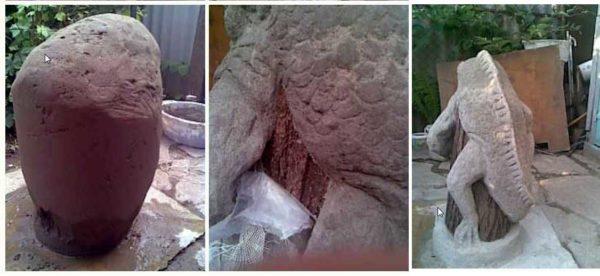
Periodically check the state of the workpiece: under your fingers there should be a solid mass, and when you apply more force, the cement is slightly squeezed. In this state you can already start to form the sculpture. You have 7-8 hours to work. For small figures it is more than enough, for large ones it is too short – you will have to hurry. To delay the drying of parts that are not yet processed, they can be wrapped with a wet cloth.
Take a knife, wire, spatulas, start to cut off the excess little by little. Do not be afraid, if something extra remove, you can later add a little bit of mortar, adjust when it dries up. In general, the technology is not too complicated, but if there is no artistic ability, it is difficult to come up with something clear. For such cases there is one trick: find a small-sized figure of any material, looking at it sculpt your own.
Making figures from cement with a base or frame
The technology of making garden figurines from concrete on the base, consists in layer-by-layer application of mortar to the frame. But this technique is required when making large figures – about 150 cm and more. Then the bearing capacity of the concrete itself may not be enough. In this case, a rigid base is required. In other cases, the frame or base is needed only to minimize the consumption of concrete and reduce the total weight of the product.
The frame for complex products is made (woven or welded) of wire, for simpler ones use improvised materials. On the finished frame is applied a layer of mortar (thick) 1-2 cm, laid with fiberglass mesh-serpyanka, again applied mortar, again mesh. The process is alternated until your product gets the desired shape.
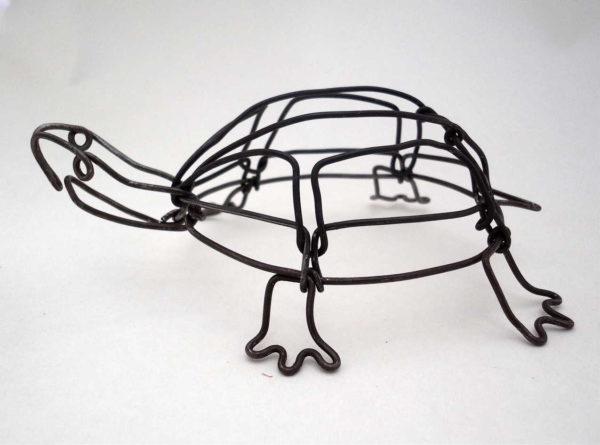
Where and how to find the base
The main task is to find a utensil, bottle, box, which in shape fits the conceived product. If the shape is complex, it can be added to it or completely created from pieces of Styrofoam. It is light, well cut. But such figures – with a base of foam plastic – do not withstand the load. If you assume that on your products can sit or otherwise mechanically influence, instead of foam plastic is better to use wooden bars or foam concrete blocks. Foam concrete is perfectly cut with a wood saw, it can be planed with a planer, a large knife, make grooves with a sharp object. The principles of working with wood are known to everyone.
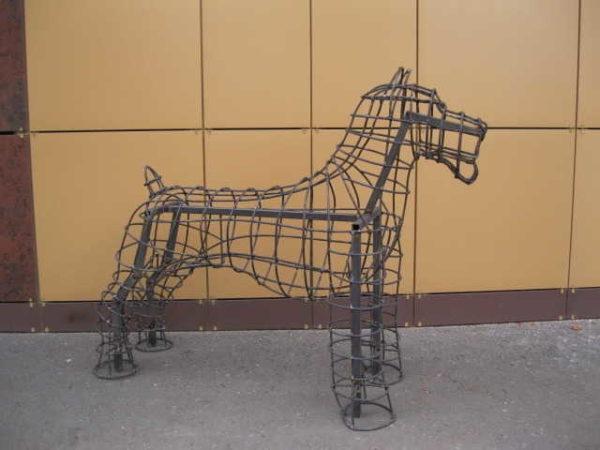
The found form is covered with mortar, wrapped with rags, hemp, ropes, and then also covered with cement. If the layer of mortar is more than 2 cm, it is reinforced with a mesh of fiberglass cloth (mesh-serpyanka is used for plastering walls). If plastic is used as a base, it is very difficult to apply the solution to it – it runs off. Such products are wrapped with rags impregnated with solution. After drying, the next layer is very well applied to them.
In the dried solution, grooves are made, which mark feathers, wool. In general, there are a lot of techniques. Let’s give some examples to make it clearer how to make garden figures from concrete. Another option – covered with mortar, into which pebbles are pressed. It creates an uneven relief.
Swans
For example, we want to make figures of swans. The basis for the body – a small rounded basin. The neck is a wire bent in the form of the letter S. “Neck” is attached to the torso by any available method.
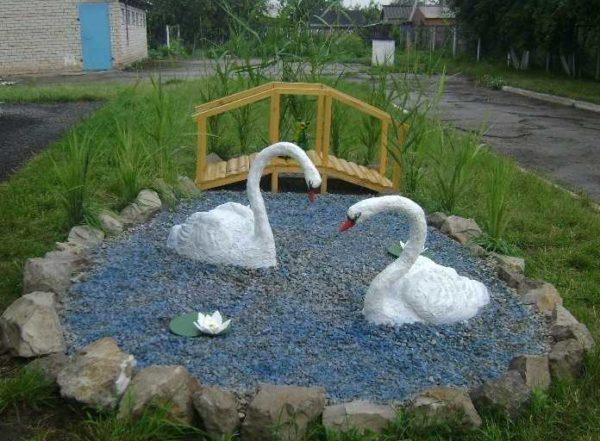
On the basin put a thick mortar, forming the desired bend add foam, pieces of rags, etc. Leave to dry. On the wire (it is better to find a thicker, you can armature) wind rags soaked in the solution. Fasten and leave everything for 24 hours. During this time, the concrete will set, and on the “body” you can use scraping to form wings, make grooves, draw feathers, etc.
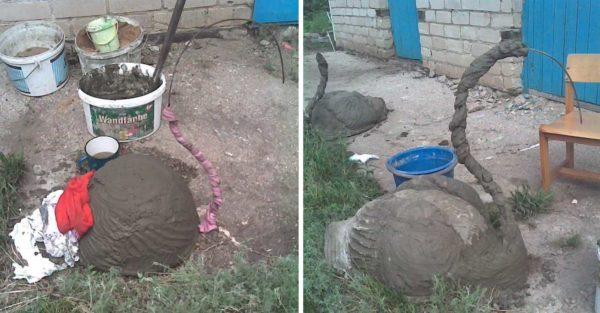
We are closely engaged in the neck and head. On the obtained base we apply the mortar with our hands (don’t forget to wear rubber gloves), forming the neck of the desired shape and thickness. You will not be able to “build up” a lot at once – only in thin layers. When the neck becomes more similar to the real one, you can start forming feathers, outline the beak, eyes, etc. Ready birds are left to dry for a week or more. Next – sanding, priming painting.
Frog Princess
On this example, we will demonstrate how you can make garden figures from cement mortar and stones. As a basis is taken foam block, trimmed and trimmed where necessary. The top is covered with thick mortar in several layers.
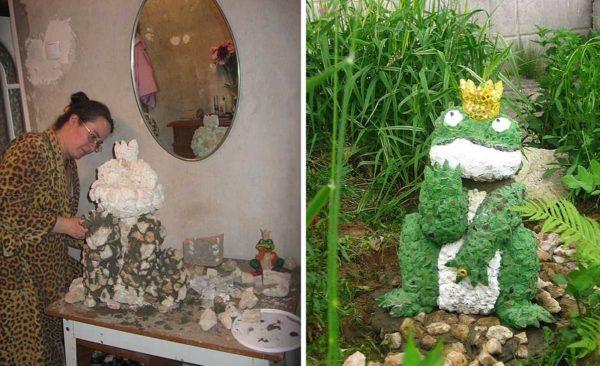
In the top, still soft, the layer is strengthened pebbles – flat pebbles of small size, glass shards are used on the crown. After drying, the figure is painted with acrylic paints and varnished twice.
Frameless technology: drinker-sheet made of concrete
If the product is small or thin, it is not planned for a large load, you can make it without a frame. So make all kinds of bowls, plates, small sculptures. For example, a drinker for birds in the form of a leaf. It can also be a stand for vases and pots with flowers, other figures that are undesirable to contact with the ground.
Find a large leaf – burdock, rhubarb, etc. The leaf is put in water, from the sand on a flat surface (table) form a gentle slide, cover it with a film.
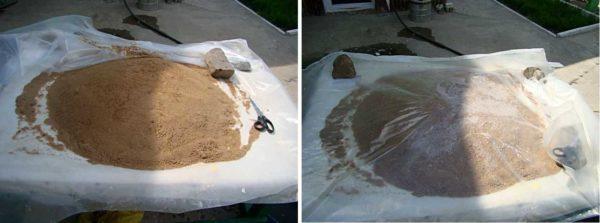
Spread the sheet on the slide, pressing it into the sand. Mix a thick mortar – it should not run off. The composition of the mortar for sculptures – for 1 part of cement, 3 parts of fine sand, you can add a plasticizer. Lay the mortar on top of the sheet, pressing it tightly. In the middle, the thickness of the layer – about 2 cm, to the edges becomes thinner – up to 1 cm. Form the edges carefully. They can be trimmed, but it is not so easy to do it.
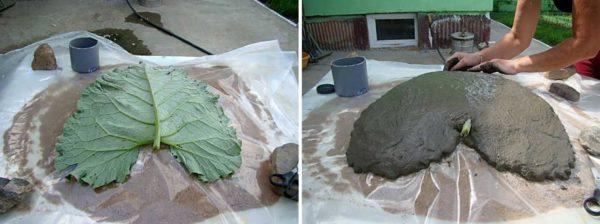
In the middle insert a piece of plastic pipe with a diameter of about 10 cm and a length of 10-15 cm. The place of the joint is covered with mortar, fill the pipe. Cover with a polyethylene film. It protects from overheating, rain and dirt. The edges are pressed with stones or something heavy, but tightness should not be achieved – excess moisture should evaporate.
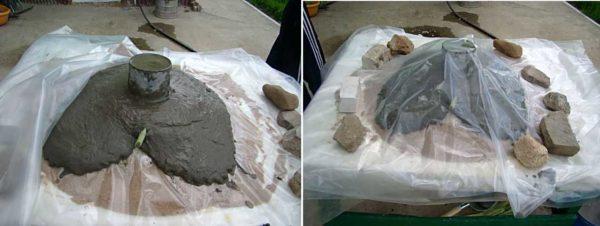
Keep the garden sculpture without turning it over for at least 2 days. Then remove the outer film, carefully turn over, remove the sheet. If it does not come off, moisten and wait a couple of minutes. With a brush, remove the residue, debris. Wait a few more days before painting – preferably two weeks.
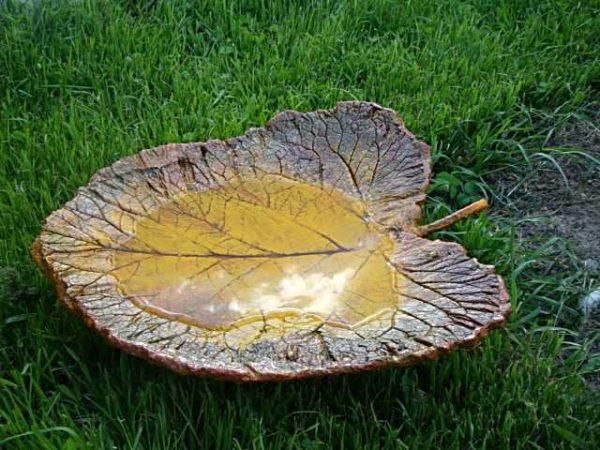
Before painting, sand with sandpaper, clean off dust. If desired, you can cover with primer. Its type is selected for the type of paint. Primer is necessary for the paint to lie down more evenly and that it is less wasted. When the paint dries, the product is covered with two layers of varnish. Choose a varnish for outdoor work. It is better – matte or semi-matte.
Decorative figures from mounting foam
Very quickly and easily you can make garden figures from mounting foam. Just note, they turn out very light, so you need some weights. As a base, plastic bottles, metal containers, cardboard boxes, etc. are suitable. For thin parts – arms, legs, necks – any materials of the right shape and size are suitable: branches, wire, wire frame, plastic pipes, metal corner, etc. etc. etc.
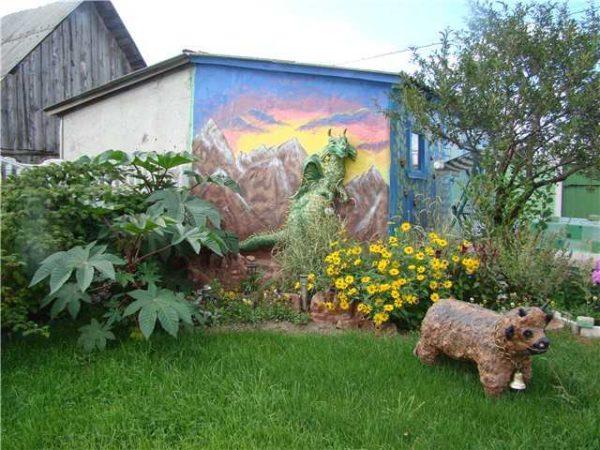
The base for thin or strongly protruding parts of figures, can be inserted later – after the “body” is ready. A wire, a corner, a stick can be simply stuck into the dried foam. If soft materials are used, they can be nailed or screwed with self-tapping screws, tacked with staples from a stapler, glued. In general, use any available method.
On the quality of foam is better not to save – choose expensive. It does not flow like a rising yeast dough, but increases in size, keeping the shape given when applying. But even with expensive assembly foam should not be in a hurry. The basic secret is as follows: apply a thin layer at a time. Then wait until it stops increasing in volume, hardens (about 25-40 minutes) and apply the next thin layer. Such a consistent build-up of volume is the key to success.
Refined technology and tips
If by steps, then make garden figures from foam should be done in this way:
In general, the technology is not complicated and now you know how to make garden figures from mounting foam. But there are nuances. First. If you bought a cheap foam and it began to spill out, you need to wait until it starts to harden, moisten your hands with water and form it into what you need. It is important to catch the moment when the foam is no longer very sticky, but has not yet solidified completely.
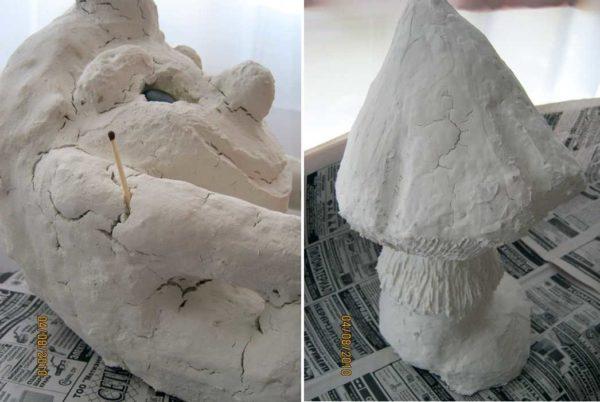
Second. If in the process a part of the figure fell off, it can be fixed by dripping foam on the joint, sticking a piece of wire – for greater strength – to connect the parts. The seam is covered with mastic, putty.
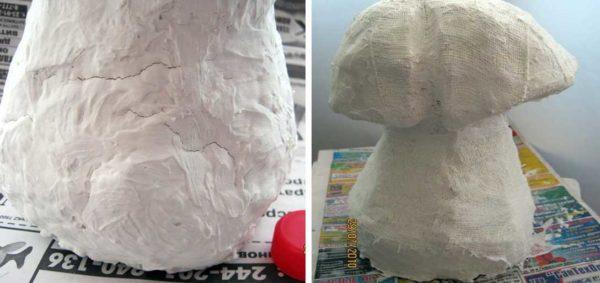
Third. When drying putty on the surface of the figure cracks are formed. Plastering them with putty again brings almost no result. Cracks appear again. To avoid them, we take a bandage, wrap the figure covered with putty, put another layer on top, smooth it out.
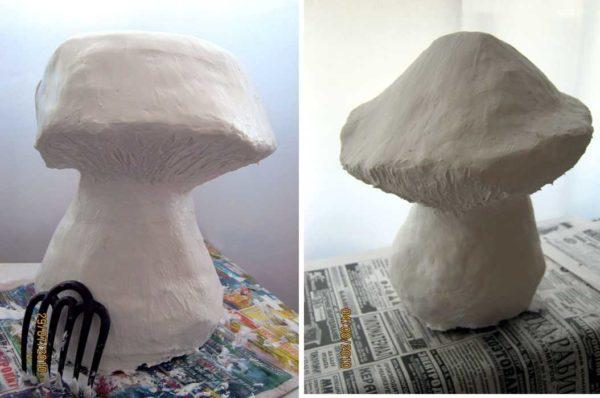
Fourth. If with the help of a spatula it was not possible to get a perfectly even surface, and you need it, then when the putty dries, it can be smoothed with your hands. If necessary, hands moisten with water.
Photo of homemade garden figures and sculptures
